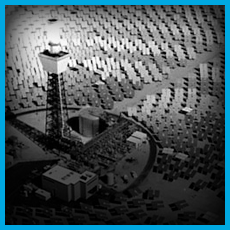OVERVIEW
Solar panels are becoming extremely efficient at the same time that the price is dropping on the materials needed to create them. For years, solar power was dismissed as inefficient and too costly to compete with other sources of electricity. That was certainly true in 1954, when silicon cells were first invented in the U.S. and only turned 6% of the energy absorbed from the sun into electricity.1 But, today available solar cells are 21% efficient, with some research panels weighing-in at close to 44% efficiency.2 The result: power costs have fallen 48% since 2010 from $5 per watt to $2.60 per watt,3 making utility-scale centralized solar power plants a cost-competitive alternative to coal and, potentially, even natural gas. Moreover, Concentrated Solar Power (CSP) technology, along with molten salt storage, solves the problem of variability of solar power.4 Yet if the U.S. is to compete in the global clean energy market and take advantage of this energy resource, we need new policies to ensure continued scaling of solar generation, maturation of technology, and domestic market growth.
ANALYSIS
The benefits of solar are clear. Solar plants often generate electricity during daily peaks of energy demand and are emissions-free. Though it costs approximately $153 to install a MWh of solar photovoltaic power today,5 many experts anticipate that increased efficiency in panels and lower prices on polysilicon and “balance of system components”6 will reduce costs to a very competitive $60 a MWh.7 This will enable solar to compete with other major power sources, even natural gas at $6 per million cubic feet.8 In states like Arizona, Nevada, California, New Jersey, and Hawaii, the solar resources could become competitive far earlier.
Yet for all of the good news, solar development in the U.S. is happening more slowly than overseas. This trend affects not only our ability to roll out solar power in the short-term, but it also means that our capability to compete for market share for solar panels and the rest of the supply chain is diminished.
In 2012, U.S. solar industry installed about 1,600 MW of large scale solar capacity.9 In addition, 1.3 GW of CSP is now being developed.10 But, small, new reforms and policies that increase solar installation growth 20% above current projections could add 1.5 GW more electricity to the grid over the next four years alone.11 If this additional capacity replaces coal generation, it would eliminate as much as 3.2 megatons of greenhouse gas emissions.12 That is the equivalent of removing more than four coal plants from the grid. The increased solar also would abate 429 tons per year of SO2, 354 tons of NOx, .006 tons of mercury, and 66 tons of particulate matter.13
IMPLEMENTATION
Easing the process for permitting and developing transmission, as well as giving solar equitable tax treatment as enjoyed by other renewable energy sources, would ensure that the U.S. continuing to be a global leader in solar power.






